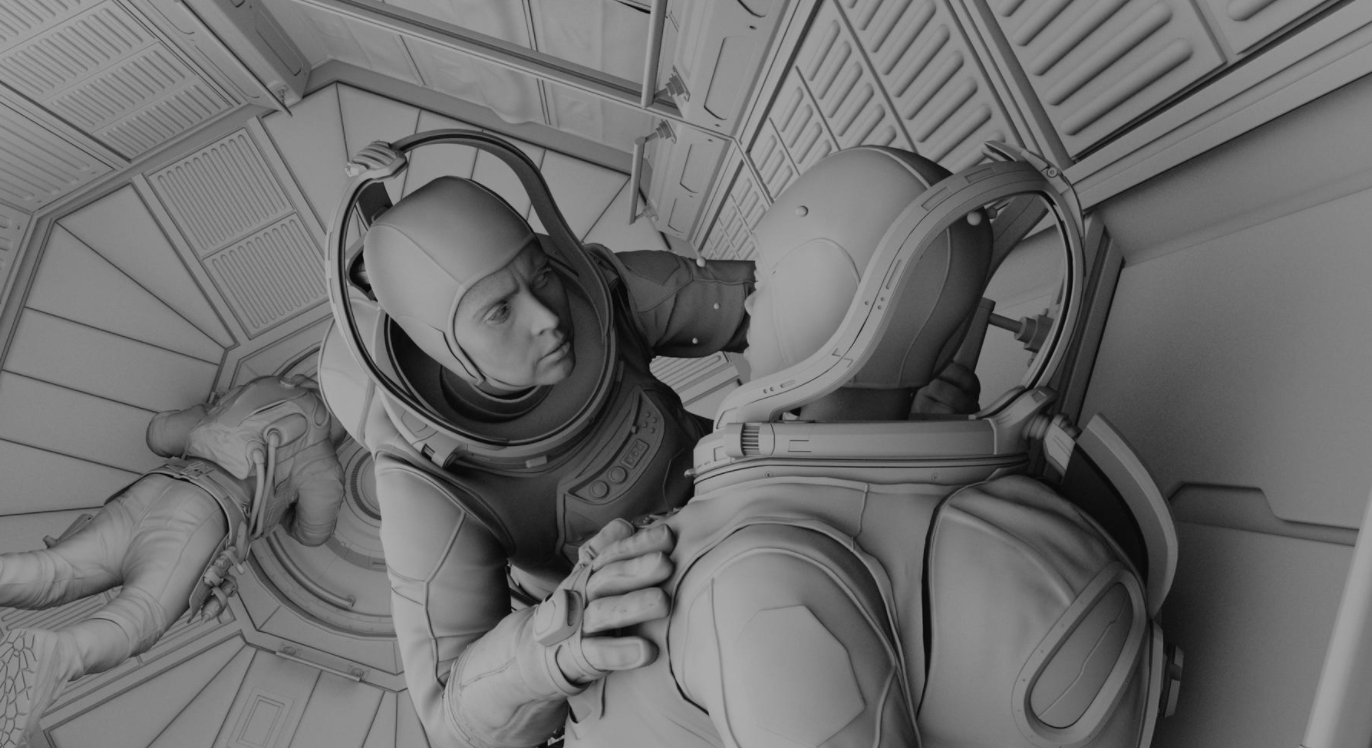There is a delicacy to George Clooney’s The Midnight Sky that we don’t normally see in stories set in space. There are some action sequences, but Clooney’s film is not an action-packed adventure story. It’s an introspective look at loneliness and grief and the visual effects from supervisors Matt Kasmir and Chris Lawrence are so beautiful at walking the line between being steeped in character and awe-inspiring.
Kasmir and I spoke about a lot of emotional moments throughout Clooney’s film. The ship Aether has a unique shape with delicate, glass shields that Kasmir told me echoed the fragility of the earth. When we finally see our planet, it’s not familiar to us. The most impressive sequence comes when one astronaut gets injured and there is an operatic, blood explosion when she takes her helmet off.
The Midnight Sky may surprise people for its lack of huge action set pieces, but its design is so steeped in the emotional advancement of its characters. Kasmir and his team have a achieved a space movie for the ages.
Awards Daily: Talk to me about designing the shape of the ship. There is something very elegant about it.
Matt Kasmir: We worked very closely with our production designer, James Bissell. Through our research, one of the most costly endeavors about going into space is physically launching into the atmosphere from Earth. There are all these plans that they send up 3D printers into space and they can harvest what they need. This is based on current thinking and we took it one step further. It’s a combination of using what was up there as the main structure of the ship and that was very International Space Station-like in that it was long and cylindrical. The rest of it was printed using found debris using these printers.
AD: Oh, that’s so cool.
MK: It was printed through an algorithm rather than design so it worked out for the dimensions needs and they created structures that fit the criteria. It was very organic. There was this traditional space language of the central piece and the rest was printed. The glass was this membrane and there were these protective shields to show the fragility of the ship relative to all the traumas that could happen in space. George [Clooney] very much wanted it to marry up with the earth itself. Maybe this big, kind of tough rock. Essentially, it’s the membrane on the top is this thin atmosphere and if it goes, we’re all dead. This was very likened to the ship. Most things were housed in this kevlar sacks, so it was just one layer of thin material between sudden death and radiation and lack of oxygen and life. It had a story point and a design point. At the end of the day, we make films and sometimes we are asked to make a fifty foot gorilla with no explanation why. Everything in this is based on real logic and expertise.


AD: That gives it so much more purpose.
MK: It really does.
AD: You mentioned Earth and there is a moment where everyone on the ship sees what Earth looks like now. How did you decide on how that would look like? It made me think, ‘Wow, that’s not our planet anymore.’
MK: Well, that was really it. Also, this wasn’t a disaster movie and it wasn’t a film about the destruction of the planet. George kept saying that the detail of this had to be incredibly vague. If we tell them it’s a nuclear holocaust, they are going to want to see pictures of destruction. This is about a man reconciling the mistakes that he made with his relationships and that was one situation where we had to show something. We wanted it shrouded and unrecognizable without giving the game away and asking too many questions. We stripped it back to make it as simple as possible. We had multilayered clouds or more dense clouds so you couldn’t see a blue, lush Eden that we are used to seeing. I personally love to see destruction shots and see things lay to waste, so it was interesting to do it in another way.
AD: And you get to do more than one city.
MK: Yes. We did all these graphical interfaces to show the destruction of the planet. We remember the language from the 1950s nuclear frenzy where you see these circles. That’s the closest we came. We weren’t going to explain more than we need to.
AD: As a side note, I appreciated how vague everything was. We have to talk about, what I am calling, the blood ballet. You’d think that a scene with a helmet engulfed in blood would be something out of a horror movie but it’s played as a really emotional moment. What the most difficult thing about that sequence?
MK: It was almost a throwaway comment. This was the easier of our zero gravity sequences. It was inside and close up. George called me up and said that it was written as a rip in Maya’s suit. He said we had seen it before but he kept thinking about liquid floating around in space. He wanted to see that and asked me if we could, and then he wanted silence and no dialogue.
AD: No pressure.
MK: All these other sequences were planned meticulously or did virtually shot the big destruction pieces for the outdoor space walk. He also wanted the camera to continually rotate during the inner airlock sequence during Maya’s death. It was a huge leap for him because he gave us that brief a week before we shot. He didn’t really see much tangible until a week before delivery. We were showing animated hero bits of blood because so much work went into it because of the rotating camera. We had to having to replace the entire set because we were running out of sets when rotating the camera since we were shooting in 2.39. We found that we were cropping all of our action so we were replacing all of our spacesuits. Eventually, we were replacing performances using facial capture. Before we even got to the blood, huge portions of that sequence were entirely CG. On top of that, we had to design how the blood came out. George didn’t want it to stick to much because it makes it more horrific. It has to be balletic.
AD: It’s startling how beautiful it is when what’s happening is so horrifying.
MK: She’s watching her life ebb away in front of her. Martin [Ruhe] shot that so well because we are never more than a meter away from Tiffany [Boone] or Felicity [Jones]’ face. It was a touching moment and incredibly technical. A lot of other directors would’ve crumbled, but George didn’t. He trusted us. He gave us some notes like changing the depth of field as the blood flowed in the last shot. Apart from that, George left it in our capable hands.


AD: I need to go back and watch it again because I didn’t notice how the blood didn’t hit the walls. That would make it like something from Alien.
MK: Exactly. It bounces on a few things in the wide shot and it hits itself but down to the one point where David [Oyelowo] puts his hand on the wound and brings his hand up and there’s some staining of blood. That’s the most that George wanted to do. We did sims where there were globules were on the fingers but it detracted from the dance of it all.
AD: One of my other favorite uses of VFX is when Sanchez visits Maya’s memories alone. I like how the memories were worn as if we were kind of misremembering some of the details. How did you go about creating those?
MK: We kind of sorted out the classic analogy of keeping a memory as a well-worn photograph. That’s basically what this was. It had to have a lot of emotion and some things are lost like you suggested. We came up with this hologram where we basically shot their favorite memory and you can relive it as a safe space. You can digress there. It helped inform the audience of the characters and we found it quite profound and sad. There is that scene where Mitchell is with his family and his memory times out, and one minute he’s with his wife and then he’s left alone. He’s just in a grey box and that sums up the isolation of being in space. w
AD: I saw some featurettes about capturing performances. Tell me about that because I had never heard of that before.
MK: Yes, it’s what we call Anyma performance which is a system pioneered by ILM in the States. What we were doing was putting the cast in a capture area and the rest of the cast would sit around them. George would direct them and we would physically capture the performance. It was treated as any other performance but it meant that we could take the performance and take that to control the CG doubles. Human digidoubles have always been a holy grail. There were so many in this film. A good example of that is in the airlock scene, there was a loss of fully CG faces. I was asked by somebody how many shots were used with digital faces, and I think we counted 70. I originally thought there were only four or five.
The Midnight Sky is streaming now on Netflix.















